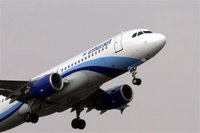
Story by : David Agren
The airport departure lounge in Toluca featured few amenities, the plane arrived in Guadalajara a little late, and a large spot made viewing one of the small in-flight entertainment screens a pain, but virtually everything else about Interjet Flight 218 went off without a hitch. And for just 600 pesos one-way, who could complain.
A flock of discount carriers, led by Interjet, took off late last year, driving down prices on some of Mexico's most heavily traveled air routes. And although inexpensive, the new airlines offer a level service comparable to their domestic counterparts – and head and shoulders above any U.S. or Canadian carrier.
The fares on the new discount carriers compare favorably to buying a seat on one of Mexico's long-distance bus companies or paying expensive highways tolls on the nation's autopistas. An ETN one-way bus ticket between Guadalajara and Mexico City costs 570 pesos; the journey lasts seven hours.
An Interjet ad reads: "Give yourself the luxury of paying less." It humbly omits mentioning the additional luxuries of flying Interjet. The airline shows in-flight entertainment, hires cheerful and helpful staff, flies modern Airbus A-320 jets and even serves complimentary beverages, including the alcoholic kind that carriers north of the border charge five dollars for. Additionally, it sells tickets via the Internet, allows customers to choose their seats and even permits last-minute itinerary changes for as little as 100 pesos.
Prior to Interjet's arrival, Mexicana and AeroMexico, which were until recently majority-owned by the same government holding company, effectively carved up the map and code shared on many routes. The competition prompted recent action from the incumbent airlines: fares between Guadalajara and Mexico City now go for as low as 999 pesos on Mexicana and AeroMexico.
Somewhat ironically, a family tied to Mexico's old guard and several titans of industry, who profited handsomely from monopoly businesses, helped bust up the old system of genteel competition. Miguel Aleman, son of a former Mexican president, founded Interjet – perhaps an appropriate line of business, considering his family's infamous role in Mexican aviation. Former president Miguel Aleman Valdes allegedly enriched himself in the 1950s by purchasing vast tracks of land in Acapulco and then having an airport built in the burgeoning resort. Carlos Slim, the world's third-richest man, and billionaire Televisa owner Emilio Azcarraga Jean milked lucrative monopoly cash cows for years, before founding Volaris, another discount carrier.
About the only real inconvenience in using new airlines: the upstarts almost exclusively use Toluca, State of Mexico as a base, meaning travelers to Mexico's capital must bus from the airport to the big city and tolerate flying from a somewhat under-developed airport. (Click, a subsidiary of Mexicana flies from both the Toluca and Mexico City airports.)
Due to congestion at Benito Juarez International Airport in Mexico City, the discount carriers base themselves in Toluca, 70 kilometers west of Mexico City. The federal government had planned to build a new airport east of the capital in Texcoco earlier this decade, but machete-wielding campesinos (peasant farmers) refused to be relocated, forcing all new airlines to use Toluca. Although a popular base for cargo flights and private jets, passenger service only recently became popular in Toluca.
The sudden surge in popularity shows. The Toluca airport still lacks many things; it only has only a few gates and no jetways for boarding flights. Set at an altitude of more than 8,000 feet, passengers can freeze while waiting for early morning flights in the winter and spring. And forget sipping a hot coffee (unless its purchased elsewhere); no kiosks operate in the Interjet and Volaris check-in areas.
On the plus side, catching a flight in Toluca requires little walking; passengers can be dropped off less than 25 meters from the check-in counter. Security, while visible, is decidedly laid back; no announcements about destroying unattended bags are read. Some motorists park their cars right next to the doors. Upon receiving their boarding passes, passengers proceed to the lone security checkpoint, which overlooks the glassed-in departure lounge. A kiosk inside hawks the usual assortment of overpriced gum, magazines and drinks, although complimentary copies of Milenio (the Mexico City version of Publico) litter the area.
Going to Toluca may seem inconvenient – and expensive, as a toll-booth near Santa Fe dings motorists with an 80-peso fee – but fortunately, the Caminante bus line motors between the airport and Mexico City's Observatorio bus station every hour for 80 pesos. A typical trip takes about an hour, although traffic conditions – always unpredictable in the Mexico City area – determine the arrival time. The buses carry on to the Centro Historico from the bus station. Volaris, a discount carrier that started Guadalajara-Toluca service on March 24, offers a free shuttle to the upscale Santa Fe district on the Federal District's western edge.
A journey from Mexico City to Toluca might fray nerves, but once aboard the airplane, the flight is anything but stressful. Passengers on Flight 218 luxuriated in comfortable leather seats – although the headrests could have used additional cushioning – that afforded plenty of legroom. The flight attendants poured complimentary shots of domestic liquor and supplied entire cans of pop and juice for mixing. In fact, the beverage cart rolled throughout the entire flight. Instead of showing an in-flight movie – the 55-minute jaunt was too brief – Interjet broadcast a brief news and entertainment report from, appropriately enough, TV Azteca. (Televisa owner Emilio Azcarraga Jean partially owns Volaris.)
After Flight 218 touched down in Guadalajara, the only real unpleasantness surfaced: the taxi monopoly was waiting to extract a minimum 150-peso fare for a ride home.


No comments:
Post a Comment